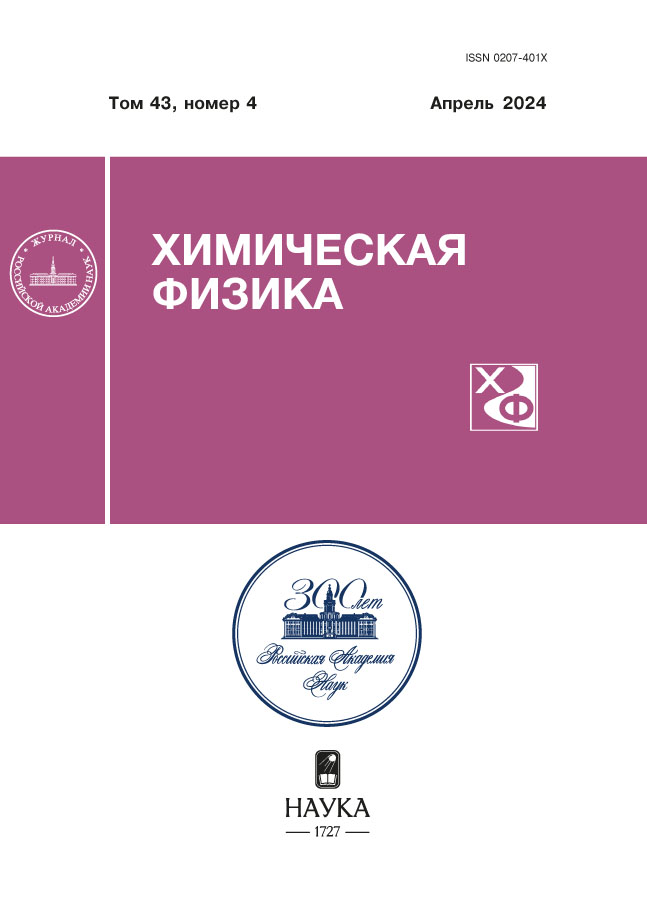Oxidation of benzene to phenol by nitrous oxide over Me-ZSM-5-zeolites with a low concentration of active sites. Role of single active sites
- Autores: Korchak V.N.1, Kuli-zade A.M.2, Silchenkova O.N.1, Udalova O.V.1
-
Afiliações:
- Semenov Federal Research Center for Chemical Physics
- Lomonosov Moscow State University
- Edição: Volume 43, Nº 4 (2024)
- Páginas: 18-28
- Seção: Kinetics and mechanism of chemical reactions, catalysis
- URL: https://cardiosomatics.ru/0207-401X/article/view/674957
- DOI: https://doi.org/10.31857/S0207401X24040038
- EDN: https://elibrary.ru/VFJUMP
- ID: 674957
Citar
Texto integral
Resumo
The ZSM-5 zeolites with Si/Al ratio 50 and 80 (ZSM-5-50 и ZSM-5-80) modified by Ca-, Sr-, Cr-, Mn- и Sb-ions were synthesized and investigated in oxidation of benzene to phenol. It was shown that more active and selective in direct oxidation of benzene by nitrous oxide are catalysts containing about 0.1–0.2% of Sb. It formally corresponds to substitution of 1/12 and 1/6 ions of H-ions by Sb-ions in ratio 1 : 1 of zeolite. Yield of phenol equal to 61.2% was obtained at 450°C and contact time 1 sec. with selectivity to phenol 96% in the presence of (ZSM-5-50 + 1/12 Sb) sample. It is about twice as much than an average value of yield reported in literature for other Me-ZSM-5 catalysts. Also, (ZSM-5-50 + 1/6 Sb) sample revealed much higher stability than other catalysts based on ZSM-5 zeolites. A model of nitrous oxide activation over single active sites (located very distant from each other) of the catalyst is suggested. The suggested model of single site adsorption and catalysis allows explain more higher efficiency of nitrous oxide as oxidant than that of molecular oxygen in reaction of direct oxidation of benzene to phenol, especially over catalysts with a low concentration (less than 0.1%) of |Me-ions.
Palavras-chave
Texto integral
Sobre autores
V. Korchak
Semenov Federal Research Center for Chemical Physics
Autor responsável pela correspondência
Email: korchak@chph.ras.ru
Rússia, Moscow
A. Kuli-zade
Lomonosov Moscow State University
Email: korchak@chph.ras.ru
Rússia, Moscow
O. Silchenkova
Semenov Federal Research Center for Chemical Physics
Email: korchak@chph.ras.ru
Rússia, Moscow
O. Udalova
Semenov Federal Research Center for Chemical Physics
Email: korchak@chph.ras.ru
Rússia, Moscow
Bibliografia
- Yu. A. Bruk, Kumol’nii sposob poluchenia fenola I acetona. L.: Khimia (1983).
- V. M. Zakoshanskii, Ros. Khim. Zh. LII, 53 (2008).
- M. Iwamoto, J. Hirata, K. Matsukami, S. Kagawa, J. Phys. Chem. 87, 903 (1983). https://doi.org/10.1021/j100229a001
- E. Suzuki, K. Nakashiro, Y. Ono, Chem. Lett. 17, 953 (1988). https://doi.org/10.1246/cl.1988.953
- G. I. Panov, V. I. Sobolev, A. S. Kharitonov, J. Molec. Catal. 61, 85 (1990). https://doi.org/10.1016/0304-5102(90)85197-P
- V. I. Sobolev, G. I. Panov, A. S. Kharitonov, et al., J. Catal. 139, 435 (1993). https://doi.org/10.1006/jcat.1993.1038
- A. S. Kharitonov, G. I. Panov, V. I. Sobolev, et al., Appl. Catal. A 82, 31 (1992). https://doi.org/10.1016/0926-860X(92)80003-U
- G.I. Panov, G.A. Sheveleva, A.S. Kharitonov, V.N. Romannikov, L.A. Vostrikova, Appl. Catal. A 82, 31 (1992). https://doi:org/10.1016/0926-860X(92)80003-U
- A. S. Kharitonov, V. I. Sobolev, G. I. Panov, Russ. Chem. Rev. 61, 1130 (1992).
- O. V. Udalova, M. Ya. Bykhovskii, M. D. Shibanova, et al., Nauka i Tekhnologia Uglevodorodov № 6, 60 (2001).
- O. V. Udalova, A. A. Firsova, M.D.Shibanova, et al., Nauka i Tekhnologia Uglevodorodov № 1, 23 (2002).
- V. N. Korchak, O. V. Udalova, M. D. Shibanova, et al., Sposob okislenia benzola v fenol, Patent R.F. № 2184722 (2001) // B.I. 2002. № 19.
- A.Y. Kucherov, A.A. Slinkin, Russ. Chem. Rev. 61, 925 (1992).
- A. A. Ivanov, V. S. Chernyavsky, M. I. Gross, et al., Appl. Catal. A 249, 327 (2003).
- V. S. Chernyavsky, I. V. Pirutko, A. K. Uriarte, et al., J. Catal. 245, 466 (2007).
- I. V. Pirutko, V. S. Chernyavsky, E. V. Starokon, et al., Appl. Catal. B: Env. 91, 174 (2009).
- L. Kustov, A. Tarasov, V. Bogdan, A. Tyrlov, Fulmer J. Catal. Today 61, 123 (2000). https://doi.org/10.1016/S0920-5861(00)00354-0
- A. L. Tarasov, L. M. Kustov, A. A. Tyrlov, et al., Proc. World Congress on Oxidation Catalysis. Potsdam, Germany P. 151 (2001).
- L. M. Kustov, A. L. Tarasov, A. M. Kuli-zade, A. A. Tyrlov, Proc. World Congress on Oxidation Catalysis. Potsdam, Germany P. 153 (2001).
- L. M. Kustov, A. L. Tarasov, A. L. Kustov, Russ. J. Phys. Chem. A 95, 9 1798 (2021). https://doi.org/10.1134/S0036024421090119
- Cui Ouvang, Yingxia Li, Jianwei LI, Catalysts 9, 44 (2019). https://doi.org/10.3390/catal9010044
- С. M. Fu, V. N. Korchak, Hall W.Keith, J. Catal. 68, 166 (1981). https://doi.org/10.1016/0021-9517(81)90049-X
- E. R. S.Winter, J. Catal. 34, 431 (1974). https://doi.org/10.1016/0021-9517(74)90056-6
- B. G. Reuben, J. W. Linnett, Trans. Faraday Soc. 55, 1543 (1959).
- B. R. Wood, J. A. Reiner, A. T. Bell, et al., J. Catal. 2004. 224, 148 (2004). https://doi.org/10.1016/j.jcat.2004.02.025
- A. L. Yakovlev, G. M. Zhidomirov, R. A.van Santen, Catal. Lett. 75, 45 (2001).
- D. A. Bulushev, L. Kiwi-Minsker, A. Renken, J. Catal. 2004. 222, 389 (2004). https://doi.org/10.1016/j.jcat.2003.11.012
- V. P. Zhdanov, Surface Rev. Lett. 16, 757 (2009). https://doi.org/10.1142/S0218625X09013116
- J. A. Ryder, A. K. Chakroborty, A. T. Bell, J. Phys. Chem. B 106, 7059 (2002). https://doi.org/10.1021/jp014705e
- J. A. Ryder, A. K. Chakroborty, A. T. Bell, J. Catal. 220, 84 (2003). https://doi.org/10.1016/S0021-9517(03)00275-6
- N. V. Dokhlikova, S. A. Ozerin, S. V. Doronin, et al., Russ. J. Phys. Chem. B 16, 461 (2022). https://doi.org/10.1134/S1990793122030137
- N. V. Dokhlikova, A. K. Gatin, S. Y.Sarvadi, et al., Russ. J. Phys. Chem B 16, 772 (2022). https://doi.org/10.1134/S1990793122040042
- M. V. Grishin, A. K. Gatin, S. Y. Sarvadi, et al., Russ. J. Phys. Chem. B 14, 697 (2020). https://doi.org/10.1134/S1990793120040065
- N. V. Dokhlikova, A. K. Gatin, S. Y. Sarvadi, et al., Russ. J. Phys. Chem. B 15, 732 (2021). https://doi.org/10.1134/S1990793121040023
Arquivos suplementares










